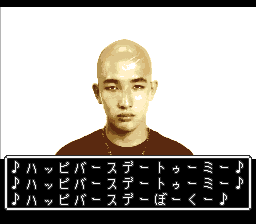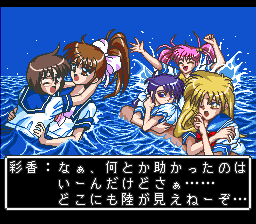The game is 23 stages back to back, with no other content other than short story sequences. The story as a whole is fairly thin -- five high school girls get brought into the world of Nage. They spend the first half of the game trying to escape, but then find that Nage is imposing itself on the real world. They go back into Nage to defeat Misty, the person that initially summoned Nage, and then defeat Nage itself. Most of the dialogue is just banter between the girls.
The first thing you do is input birthdays for the 5 girls.
This affects the birthday stone system in the battles, but there are two special things you can do. If you put in the birthdays as 1/23, 4/5, 6/7, 8/9, and 10/11, all cards count as birthday stones, making the game much easier. If you do 10/10, 3/3, 2/14, 7/7, and 12/24 you can see profiles of the girls. If you put everyone as 11/25, when you beat the game you get this unknown bald guy singing Happy Birthday to Me (a designer?)

Everyone can move 6 spaces on the map regardless of the terrain. What the terrain does it affect the speed that your turn gauge fills, and some of the map squares are damage or healing.
The battle system is interesting. It's based on a card system, but not deck-building as such. Each encounter is 6 rounds (or until one person dies). At the beginning of each battle there is a random hand of 5 cards. When you use one of the cards, it will get replaced by another random one. Everyone shares the same hand so you do sometimes have to use less-than-optimal cards to clear them out of your hand. Each card has two numbers; a power at the top left and a speed at the bottom right. Who actually goes first is affected also by the character's speed stat in addition to the speed of the card. There is also a gemstone on each card, and if it matches the character's birthday gemstone, it automatically has max power (15).
The types of cards are:
- Attack
- Defense (raise defense just for that battle)
- Heal
- SP (a special super attack)
- COS - This changes your costume.The Winter costume gives you more def/agl at the cost of str/mt. Gym clothes are +str/agl, -def. Swimsuit is +str/-def (more than Gym). Coat is just +10% def. The costume change just lasts until the end of the stage.
- CHG - This allows you to pull one of your stock cards. Between battles you can buy up to 5 stock cards for each person. All of them have 9 speed and X (maximum) power. At the beginning of the game you have to be somewhat frugal, but starting around mid-game I always had one heal and four SP cards to draw from.
- Escape (end the battle, can fail)
- ????? - random effect, although I swear that defense is the most common outcome -- maybe this is just confirmation bias though.
One other thing I'm not sure about is the level advancement. There's no XP; the girls gain levels at the end of the stage, but I can't tell whether it has anything to do with what they did during the stage.
There are a lot of interface issues. It's very hard to see the stats of your girls during the stage, and there's too much opacity in the system (although some of that might be cleared up by the instruction manual).
In the end this is not a bad game, but it's not particularly good either. I'll be interested to see what the PSX game changes in the system. I read one complaint that there aren't as many clubs, but that doesn't seem like a bad thing to me. I did notice that they made some changes that reduce the randomness of the card draw a bit, which is probably good -- it can be frustrating at times when you're drawing nothing but costume change and escape cards.
After you win the game you can play an Extra Stage with all the bosses on one map.
Next up we'll be back to 1996 for Vagrant Story, a game I have heard about but never played.
















